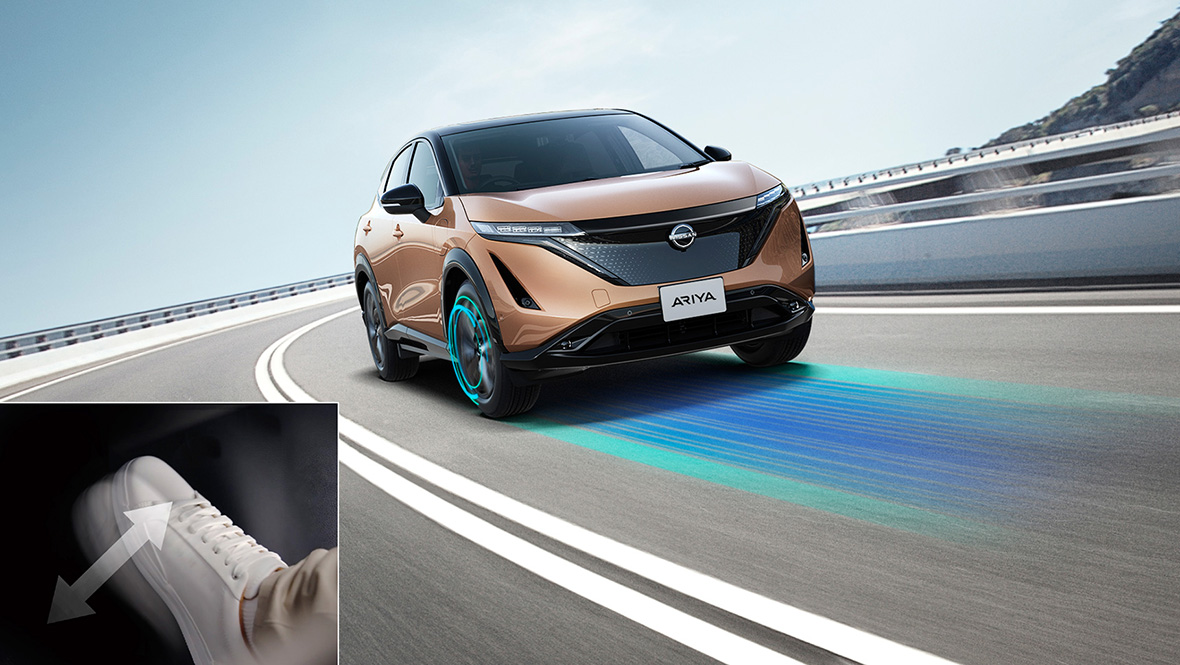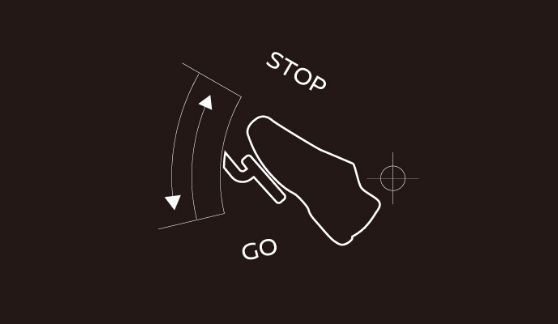e-Pedal Step
Free control of the vehicle’s speed with just the accelerator pedal*
Taking full advantage of the unique characteristics of motor drive vehicles, if the driver steps on the accelerator, then the vehicle will accelerate as expected, and if the driver releases the accelerator, the vehicle will decelerate smoothly and firmly due to motor regeneration.
Because the vehicle‘s speed can be adjusted through the use of just the accelerator pedal, the frequency of stepping on the brakes is reduced and there is a decrease in driving effort for city driving, which has repeated acceleration and deceleration. For winding, continuous curves, speed control via the accelerator pedal makes drives even more enjoyable.
Additionally, e-Pedal Step makes driving on snowy and other slippery roads safer and more secure. In addition to suppressing disturbances to the vehicle‘s behavior from stepping on the brakes, e-Pedal Step also makes it possible to smoothly and stably decelerate by detecting tire slip and precisely controlling the strength of the regenerative braking.
Furthermore, in vehicles with coordinated braking control, stable deceleration is achieved in a wider range of situations via combined use with hydraulic brakes.

- Unlike with e-Pedal that has been used in the past, with e-Pedal Step that has been installed in new vehicles since 2020, instead of the stop and stop-hold function after deceleration, the vehicle creeps after deceleration when the driver's foot is off the accelerator, so it is necessary to step on the brake when the vehicle is stopped.
System Operation
When the accelerator pedal is released, the motor‘s regenerative braking generates a strong deceleration force that is approx. three or more* times the deceleration force of a conventional engine brake, making it possible to control vehicle speed with just the accelerator.
The strength of the deceleration changes according to the amount that the accelerator pedal is released. Releasing it a small amount produces a weak deceleration and releasing it a large amount produces a strong deceleration.
Additionally, the strength of the deceleration changes according to the vehicle‘s speed. In the low to medium speed range, where traffic speed fluctuates widely, it firmly decelerates. In the high speed range the deceleration is kept low so that the driver doesn't have to pay attention to operating the accelerator when cruising on a highway for long periods of time.
Furthermore, in the very low speed range, regenerative braking is not activated and the vehicle creeps, making it easier for the driver to control their stop position when parking.
On slippery roads, stable deceleration is achieved even on snowy roads, etc. by constantly monitoring the slip state of the tires and controlling the strength of the regenerative braking according to the degree of slippage.
Furthermore, in vehicles with coordinated braking control, the hydraulic brakes are automatically activated according to the situation when the accelerator is released. Even if regenerative braking alone cannot exert sufficient deceleration power, such as when the battery is fully charged or on a frozen road, stable deceleration is achieved at all times via combined use with the hydraulic brakes.


- Maximum deceleration varies depending on vehicle model.
EV/e-POWER vehicles with coordinated braking control: Approx. 0.20G
e-POWER vehicles without coordinated braking control: Approx. 0.15G (D (Drive) position), approx. 0.18G (2WD models in B position), approx. 0.20G (4WD models in B position)
System Mechanism
Deceleration occurs via motor regeneration, and the energy generated in the process charges the battery.
According to the position of the accelerator pedal and the speed of the vehicle, by controlling the regenerative current with an inverter, the strength of deceleration is controlled.
Additionally, the slip state of tires is monitored from the wheel speed sensors, and stable deceleration can be achieved even on slippery road surfaces by precisely controlling the amount of regeneration according to the degree of slippage.
Furthermore, in vehicles with coordinated braking control, the hydraulic brake is automatically activated in response to situations of decelerating when the accelerator is off. A highly responsive electric brake booster controls the hydraulic brakes on the four wheels.



